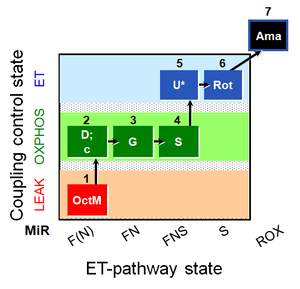Difference between revisions of "Template:SUIT-017"
| Line 11: | Line 11: | ||
| [[Fatty acid oxidation pathway control state| F(N)]] | | [[Fatty acid oxidation pathway control state| F(N)]] | ||
| FAO | | FAO | ||
| | | 1OctM | ||
{{Template:SUIT F}} {{Template:SUIT M low}} {{Template: SUIT L(n)}} | {{Template:SUIT F}} {{Template:SUIT M low}} {{Template: SUIT L(n)}} | ||
| Line 29: | Line 29: | ||
| [[FN]] | | [[FN]] | ||
| F&CI | | F&CI | ||
| 1OctM;2D;3G | | 1OctM;2D;3G | ||
{{Template:SUIT N}} {{Template:SUIT F}} {{Template:SUIT OXPHOS}} | {{Template:SUIT N}} {{Template:SUIT F}} {{Template:SUIT OXPHOS}} | ||
|- | |- | ||
| Line 47: | Line 38: | ||
| [[FNS]] | | [[FNS]] | ||
| F&CI&II | | F&CI&II | ||
| 1OctM;2D;3G | | 1OctM;2D;3G;4S | ||
{{Template:SUIT NS}} {{Template:SUIT F}} {{Template:SUIT OXPHOS}} | {{Template:SUIT NS}} {{Template:SUIT F}} {{Template:SUIT OXPHOS}} | ||
| Line 56: | Line 47: | ||
| [[FNS]] | | [[FNS]] | ||
| F&CI&II | | F&CI&II | ||
| 1OctM;2D;3G | | 1OctM;2D;3G;4S;5U | ||
{{Template:SUIT NS}} {{Template:SUIT F}} {{Template:SUIT ET}} | {{Template:SUIT NS}} {{Template:SUIT F}} {{Template:SUIT ET}} | ||
| Line 65: | Line 56: | ||
| [[S]] | | [[S]] | ||
| CII | | CII | ||
| 1OctM;2D;3G | | 1OctM;2D;3G;4S;5U;6Rot | ||
{{Template:SUIT Rot}} {{Template:SUIT ET}} | {{Template:SUIT Rot}} {{Template:SUIT ET}} | ||
| Line 74: | Line 65: | ||
| | | | ||
| | | | ||
| 1OctM;2D;3G | | 1OctM;2D;3G;4S;5U;6Rot;7Ama | ||
{{Template:SUIT ROX}} | {{Template:SUIT ROX}} | ||
|} | |} | ||
{{Template:Keywords in SUIT protocols}} | {{Template:Keywords in SUIT protocols}} | ||
Revision as of 18:17, 26 February 2019
Steps and respiratory states
| Step | State | Pathway | Q-junction | Comment - Events (E) and Marks (M) |
|---|---|---|---|---|
| 1OctM | OctML | F(N) | FAO | 1OctM
Respiratory stimulation of the FAO-pathway, F, by fatty acid, FA, in the presence of malate, M. Malate is a type N substrate (N), required for the F-pathway. The FA concentration has to be optimized to saturate the F-pathway, without inhibiting or uncoupling respiration. Low concentration of malate, typically 0.1 mM, does not saturate the N-pathway; but saturates the F-pathway. Non-phosphorylating resting state (LEAK state); LEAK respiration L(n) in the absence of ADP, ATP, AMP (no adenylates). |
| 2D | OctMP | F(N) | FAO | 1OctM;2D
Respiratory stimulation of the FAO-pathway, F, by fatty acid, FA, in the presence of malate, M. Malate is a type N substrate (N), required for the F-pathway. The FA concentration has to be optimized to saturate the F-pathway, without inhibiting or uncoupling respiration. Low concentration of malate, typically 0.1 mM, does not saturate the N-pathway; but saturates the F-pathway. OXPHOS capacity P (with saturating [ADP]), active OXPHOS state. |
| 3G | OctGMP | FN | F&CI | 1OctM;2D;3G
NADH-linked substrates (type N-pathway to Q). Respiratory stimulation of the FAO-pathway, F, by fatty acid, FA, in the presence of malate, M. Malate is a type N substrate (N), required for the F-pathway. The FA concentration has to be optimized to saturate the F-pathway, without inhibiting or uncoupling respiration. OXPHOS capacity P (with saturating [ADP]), active OXPHOS state. |
| 4S | OctGMSP | FNS | F&CI&II | 1OctM;2D;3G;4S
Respiratory stimulation by simultaneous action of type N substrates & succinate, with convergent electron flow in the NS-pathway for reconstitution of TCA cycle function. Respiratory stimulation of the FAO-pathway, F, by fatty acid, FA, in the presence of malate, M. Malate is a type N substrate (N), required for the F-pathway. The FA concentration has to be optimized to saturate the F-pathway, without inhibiting or uncoupling respiration. OXPHOS capacity P (with saturating [ADP]), active OXPHOS state. |
| 5U | OctGMSE | FNS | F&CI&II | 1OctM;2D;3G;4S;5U
Respiratory stimulation by simultaneous action of type N substrates & succinate, with convergent electron flow in the NS-pathway for reconstitution of TCA cycle function. Respiratory stimulation of the FAO-pathway, F, by fatty acid, FA, in the presence of malate, M. Malate is a type N substrate (N), required for the F-pathway. The FA concentration has to be optimized to saturate the F-pathway, without inhibiting or uncoupling respiration. Noncoupled electron transfer state, ET state, with ET capacity E. |
| 6Rot | SE | S | CII | 1OctM;2D;3G;4S;5U;6Rot
Succinate pathway control state (S-pathway) after inhibiting CI with rotenone, which also inhibits the F-pathway. Noncoupled electron transfer state, ET state, with ET capacity E. |
| 7Ama | ROX | 1OctM;2D;3G;4S;5U;6Rot;7Ama
Rox is the residual oxygen consumption in the ROX state, due to oxidative side reactions, estimated either after inhibition of CIII (e.g. antimycin A, myxothiazol), CIV (e.g. Cyanide) or in the absence of endogenous fuel-substrates. Rox is subtracted from oxygen flux as a baseline for all respiratory states, to obtain mitochondrial respiration. |
- Bioblast links: SUIT protocols - >>>>>>> - Click on [Expand] or [Collapse] - >>>>>>>
- Coupling control
- Pathway control
- Main fuel substrates
- » Glutamate, G
- » Glycerophosphate, Gp
- » Malate, M
- » Octanoylcarnitine, Oct
- » Pyruvate, P
- » Succinate, S
- Main fuel substrates
- Glossary

